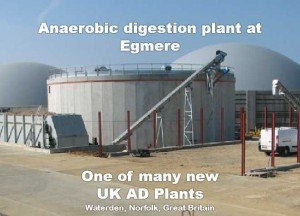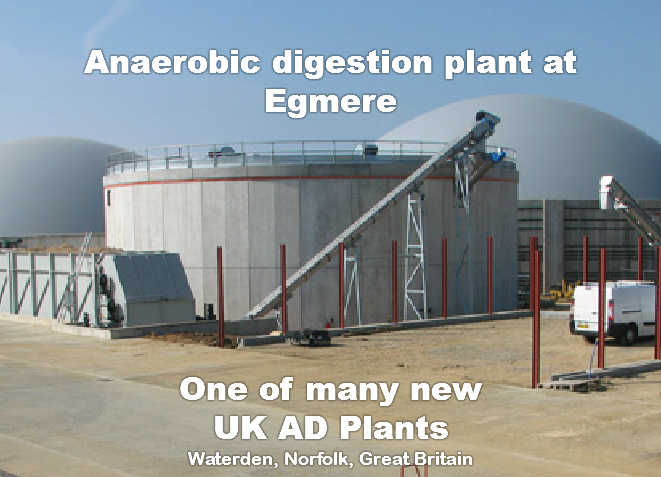“A Natural Process Returns to Prominence”
So, what is Anaerobic Digestion? Anaerobic Digestion involves using the natural process wherein organic matter is broken down by germs, in the absence of oxygen, inside a sealed tank.
For both processes, a digester tank is made use of: a gas-tight, sealed vessel with draw-off points, in which plant and animal material (biomass) is naturally digested by micro-organisms, which then release functional methane.
Here is the definition which is provided by the US Government Massachusetts website:
What is Anaerobic Digestion (AD) and how does it work?
Anaerobic digestion (AD) is a biological process in which micro-organisms break down organic materials in the absence of oxygen and form an energy-rich biogas. In the “wet” version of AD, pumpable organic feedstocks (such as food processing waste or animal manure) are placed in an enclosed chamber that is maintained between 95 to 140 degrees Fahrenheit, typically for about three to four weeks. Naturally occurring fermentation micro-organisms that thrive in this heated environment break down the organic solids and “methanogens” produce biogas, comprised primarily of methane and carbon dioxide. “Dry” AD systems operate similarly, but can handle feedstocks with lower moisture content like table scraps or yard waste.
While the digestion process greatly reduces the volume of solids, reduction varies depending on the feed source, temperature, and amount of time the solids are retained in the digester. The leftover digested material is rich in nutrients and may be used directly as a fertilizer or soil amendment, or mixed with other materials and composted. via: www.blog.mass.gov
— Watch Our Video Below for an Explanation of “What is Anaerobic Digestion?”. —
[box type=”note”]Keep in mind: According to data on Biogas-Info.com, although a digester tank can accept waste from markets, residences and supermarkets, it is slurry and manure from farms that is most regularly processed. As long as the tank's contents are: mechanically stirred and heated up appropriately throughout, and the settling of solids and crust development can be stayed clear of, the process can be very effective.[/box]
 Attribution: Anaerobic digestion plant at Egmere (Evelyn Simak) / CC BY-SA 2.0
Attribution: Anaerobic digestion plant at Egmere (Evelyn Simak) / CC BY-SA 2.0This produces:
- Biogas – usable as a renewable energy source, for heat and power
- Biomethane – usable as a transport fuel or it can be injected into the UK natural gas grid, and
- Carbon dioxide – usable in fire extinguisher systems, aerosol cans, soft drinks, food production in greenhouses, coffee decaffeination, and for numerous other purposes
Plus, afterwards, the treated material (digested effluent, or “digestate”) can be used as a nutrient-rich fertiliser and soil conditioner.
AD reduces:
- Fossil fuel use
- Greenhouse gas emissions from landfill, and
- Methane emissions to the atmosphere from manures and slurries.
It allows farmers and other rural business owners to:
- Cut their energy bills
- Better manage waste
- Reduce their environmental footprint, and
- Enjoy an increased income – the sale of surplus energy and digestate offers a potential additional revenue stream
- enjoy the knowledge that they were doing their bit toward improving the sustainability of their businesses and in a small way helping to cut national carbon emissions as is so much needed everywhere, so that climate change can be reduced.
With all this, it is not surprising that many businesses and communities are increasingly looking to benefit from Anaerobic Digestion, and the marsh gas (methane) it produces, as first identified by Alessandro Volta. To put it another way, people who asked what is anaerobic digestion, and understood the answer a while ago, are now getting involved with it. some are building their own biogas plants, and many others are promoting the knowledge of this amazing process.
There is also a growing trend of AD plants being set up by entrepreneurs looking to gain market presence as an energy supplier, and to win government contracts for energy supply at subsidised rates known as the “Feed-in-Tariff” and “Renewable Heat Initiative” (RHI) in the UK.
Types of AD
There are two basic AD processes:
- Mesophilic digestion, which occurs between a temperature range of 20-40ºC, and can take a month or two to complete
And:
- Thermophilic digestion, which occurs between 50-65ºC and is faster, resulting in smaller reactor tank sizes, but the bacteria are more sensitive to imperfect conditions.
In all types of anaerobic digestion process the work of fermentation is carried out by bacterial, and archaea. Archaea are a sub-division of bacteria but they are very different, possibly because their origins are thought to be extremely old.
We hope that this clarifies your question for more details about biogas facilities visit our homepage “anaerobic digestion home“.
What is Anaerobic Digestion? – More Background Info
[box type=”info”]The 2009 EU Renewable Energy Directive sets a target for the UK to achieve 15 per cent of its energy consumption from renewable sources by 2020, according to The Department for Energy and Environment Modification. Business and organisations across the country are therefore being urged by the Government to do all they can to attain this goal. Lots of farmers, other rural company owner, and water utility businesses are certainly doing their bit to producing renewable resource and getting rid of excessive greenhouse gas production, by diverting biodegradable wastes to Anaerobic Digestion (AD): a process that includes the natural breakdown in digester tanks of natural products into methane, CO2 gas and fertiliser.[/box]
Definitions of Basic Anaerobic Digestion Terms Used
“microorganisms” – “A microorganism
“biodegradable” – “Biodegradation is the disintegration of materials by bacteria
“oxygen” – “Oxygen is a chemical element with symbol O and atomic number 8. It is a member of the chalcogen group on the periodic table
“manage waste” – “Waste management or waste disposal are all the activities and actions required to manage waste from its inception to its final disposal. This includes amongst other things collection
“fermentation” – “Fermentation is a metabolic process that consumes sugar in the absence of oxygen. The products are organic acids
“digestion” – “Digestion is the breakdown of large insoluble food molecules into small water-soluble food molecules so that they can be absorbed into the watery blood plasma . In certain organisms
“Alessandro Volta” – “Alessandro Giuseppe Antonio Anastasio Volta ( Italian: ; 18 February 1745 – 5 March 1827) was an Italian physicist
“bacterial” – “Acidobacteria Actinobacteria Aquificae Armatimonadetes Bacteroidetes Caldiserica Chlamydiae Chlorobi Chloroflexi Chrysiogenetes Cyanobacteria Deferribacteres Deinococcus-Thermus Dictyoglomi Elusimicrobia Fibrobacteres Firmicutes Fusobacteria Gemmatimonadetes Lentisphaerae Nitrospirae Planctomycetes Proteobacteria Spirochaetes Synergistetes Tenericutes Thermodesulfobacteria Thermotogae Verrucomicrobia Synonyms Eubacteria Woese & Fox
“hydrolysis” – “Hydrolysis ( / h aɪ d r ɒ l ɪ s ɪ s / ; from Ancient Greek hydro-
“organic polymers” – “A polymer ( / p ɒ l ɪ m ər / ; Greek poly-
“carbohydrates” – “A carbohydrate ( / k ɑːr b oʊ h aɪ d r eɪ t / ) is a biomolecule consisting of carbon (C)
“Acidogenic bacteria” – “Acidogenesis is the second stage in the four stages of anaerobic digestion : Hydrolysis : A chemical reaction where particulates are solubilized and large polymers converted into simpler monomers ; Acidogenesis: A biological reaction where simple monomers are converted into volatile fatty acids ; Acetogenesis : A biological reaction where volatile fatty acids are converted into acetic acid
“sugars” – “Sugar is the generic name for sweet -tasting
“amino acids” – “Amino acids are organic compounds containing amine (-NH 2 ) and carboxyl (-COOH) functional groups
“hydrogen” – “Hydrogen is a chemical element with symbol H and atomic number 1. With a standard atomic weight of 7000100800000000000 1.008
“ammonia” – “Trihydrogen nitride Nitrogen trihydride Identifiers CAS Number 7664-41-7 Y 3D model ( JSmol ) Interactive image 3DMet B00004 Beilstein Reference 3587154 ChEBI CHEBI:16134 Y ChEMBL ChEMBL1160819 Y ChemSpider 217 Y ECHA InfoCard 100.028.760 EC Number 231-635-3 Gmelin Reference 79 KEGG D02916 Y MeSH Ammonia PubChem CID 222 RTECS number BO0875000 UNII 5138Q19F1X Y UN number 1005 InChI InChI=1S/H3N/h1H3 Y Key:QGZKDVFQNNGYKY-UHFFFAOYSA-N Y InChI=1/H3N/h1H3 Key:QGZKDVFQNNGYKY-UHFFFAOYAF SMILES N Properties Chemical formula NH 3 Molar mass 17.031 g/mol Appearance Colourless gas Odor strong pungent odour Density 0.86kg/m 3 (1.013 bar at boiling point) 0.769 kg/m 3 (STP) 0.73kg/m 3 (1.013 bar at 15°C) 681.9kg/m 3 at −33.3°C (liquid) See also Ammonia (data page) 817kg/m 3 at −80°C (transparent solid) Melting point −77.73°C (−107.91°F; 195.42K) ( Triple point at 6.060 kPa
“organic acids” – “An organic acid is an organic compound with acidic properties. The relative stability of the conjugate base of the acid determines its acidity. In biological systems
“acetic acid” “Acetamide Acetic anhydride Acetonitrile Acetyl chloride Ethanol Ethyl acetate Potassium acetate Sodium acetate Thioacetic acid: Supplementary data page Structure and properties Refractive index ( n )
“methanogens” – “Methanogens are microorganisms that produce methane as a metabolic byproduct in anoxic conditions. They are prokaryotic and thus belong to the kingdom Monera
“sewage sludge” – “Sewage sludge refers to the residual
“waste management” – “Waste management or waste disposal are all the activities and actions required to manage waste from its inception to its final disposal. This includes amongst other things collection
“landfill gas” – “Landfill gas is a complex mix of different gases created by the action of microorganisms within a landfill . Landfill gas is approximately forty to sixty percent methane
“maize” – “Maize ( / m eɪ z / MAYZ ; Zea mays subsp. mays
“renewable energy” – “Renewable energy is energy that is collected from renewable resources
“biogas” – “Biogas typically refers to a mixture of different gases produced by the breakdown of organic matter in the absence of oxygen. Biogas can be produced from raw materials such as agricultural waste
“methane” – “Methane ( US : / m ɛ θ eɪ n / or UK : / m iː θ eɪ n / ) is a chemical compound with the chemical formula CH 4 (one atom of carbon and four atoms of hydrogen ). It is a group-14 hydride and the simplest alkane
“carbon dioxide” – “Carbon dioxide ( chemical formula CO 2 ) is a colorless gas with a density about 60% higher than that of dry air. Carbon dioxide consists of a carbon atom covalently double bonded to two oxygen atoms. It occurs naturally in Earth's atmosphere as a trace gas . The current concentration is about 0.04% (410 ppm ) by volume
“biomethane” – “Renewable Natural Gas (RNG)
“digestate” “Digestate is the material remaining after the anaerobic digestion of a biodegradable feedstock. Anaerobic digestion produces two main products: digestate and biogas . Digestate is produced both by acidogenesis and methanogenesis and each has different characteristics. Contents 1 Acidogenic digestate 2 Methanogenic digestate 3 Uses 4 Digestate and compost 5 Standards for digestate 6 See also 7 References”
“fertilizer” – “A fertilizer ( American English ) or fertiliser ( British English ; see spelling differences ) is any material of natural or synthetic origin (other than liming materials ) that is applied to soils or to plant tissues to supply one or more plant nutrients essential to the growth of plants . Many sources of fertilizer exist
“capital costs” “Capital costs are fixed.”

This is the most suitable blog for anyone who wants to find out about the topic of anaerobic digestion which most people call biogas.
Rarely I leave a comment/ review
Well presented material
Millions of people will get benefit of this amazing material
Thanks a million